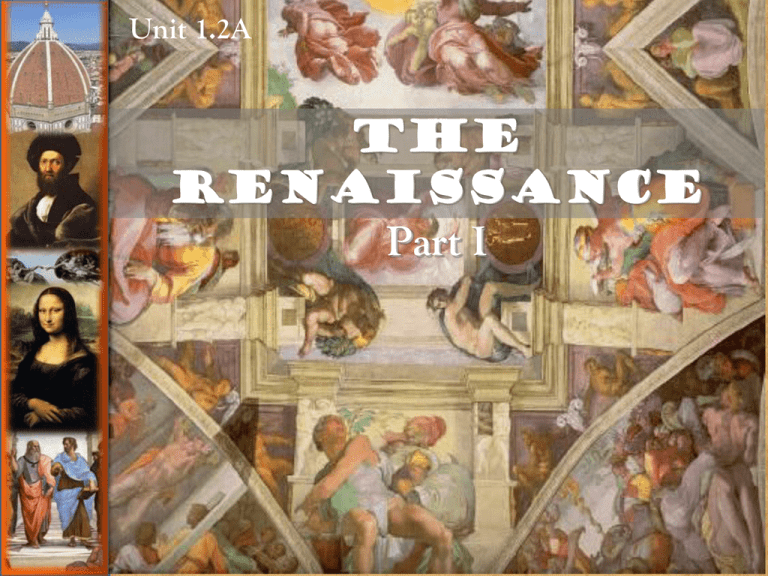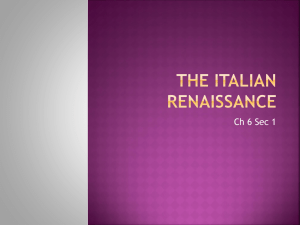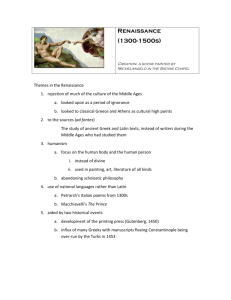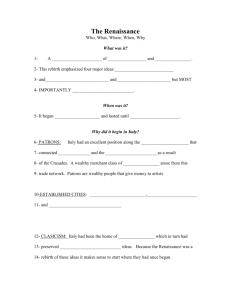File - AP EURO
advertisement

Unit 1.2A THE RENAISSANCE Part I The Renaissance I. Background A. Renaissance is considered the beginning of modern European history B. Renaissance (c. 1300-1600) 1. Occurred first in Italy c. 1300 and lasted until 1527 2. The Renaissance spread to Northern Europe around 1450 3. In England, the Renaissance did not begin until the 16th century and lasted to the very early 17the century (e.g. Shakespeare) C. Origins of the concept of a “renaissance”: 19th-century historian Jacob Burckhardt claimed the Renaissance stood in stark contrast to the Middle Ages D. Renaissance culture applied almost exclusively to the upper classes 1. Upper classes had the luxury of time to spend learning the classics 2. The peasantry was largely illiterate 3. Working classes and small merchants were preoccupied with the concerns of daily life II. Rise of the Italian city-states A. Northern cities developed international trade: Venice, Genoa, and Milan 1. By 1300, signori (despots), or oligarchies (rule of merchant aristocracies) controlled all of the Italian peninsula. 2. Commenda: a contract between a merchant and “merchant-adventurer” who agreed to take goods to distant locations and return with the proceeds (for 1/3 of the profits) 3. Italy became more urban: it had more towns and cities with significant populations than anywhere else in Europe at this time Italian CityStates in the late-15th century B. Politics among the Italian City-States 1. Competition among city-states meant that Italy did not unify politically a. In effect, an early balance of power emerged b. Political disunity eventually led to the downfall of the city-states in the late 1400s and early 1500s 2. Condottieri: mercenary generals of private armies who were hired by citystates for military purposes Leonardo da Vinci, Condotierri, c. 1476 C. Major city-states and figures 1. Republic of Florence (included Genoa) a. Center of the Renaissance during the 14th and 15th centuries b. Dominated by the Medici family c. Cosimo de Medici (1389-1464): allied with other powerful families in Florence and became the unofficial ruler of the republic d. Lorenzo the Magnificent (1449-1492): perhaps the greatest patron of the arts A 15th-century portrait by Angelo Bronzino 1480, painted terracotta bust by Verrocchio, 1480 2. Duchy of Milan a. Ruled by the Sforza family after 1450 b. Milan was a major enemy of Florence and Venice c. Peace of Lodi (1454) created a 40-year period of relative peace 3. Rome, the Papal States: Popes served as religious & political leaders; controlled much of central Italy 4. Venice, Venetian Republic a. Longest lasting of the Italian city-states b. Greatest maritime power in Italy 5. Naples, Kingdom of the Two Sicilies a. Included southern Italian region of Naples and the island of Sicily b. Only Italian city-state to officially have a “king” c. Controlled by France between 1266-1435 d. Controlled by Spain after 1435 D. Decline of the Italian City-States 1. French invasion of Italy began in 1494. a. Milan’s despot, Ludovico “the Moor” invited French King Charles VIII (1483-1498) to invade Naples, Milan’s traditional enemy. b. This was the beginning of foreign invasions in Italy. 2. Florence a. When Florence tried to appease France during its 1494 invasion, it led to the overthrow of the Medici family b. Girolamo Savonarola became the unofficial ruler of Florence between 1494-1498 • Pledged to rid Florence of its decadence and corruption • Oversaw a theocracy • Predicted French invasions due to the paganism & moral decay of Florence (and other states) • When France was removed from Italy in 1498, he was burned at the stake 3. Italy became a battleground in a series of struggles between Spain and France -- Spanish fears of a French-Italian alliance led to its alliance with Venice, the Papal States and the Holy Roman Empire 4. Niccolò Machiavelli: The Prince (1513) a. Quintessential political treatise of the 16th century b. Observed the political leadership of Cesare Borgia (son of Pope Alexander VI) who had ambitions of uniting Italy under his control c. Stated that politically, “the ends justifies the means” d. For rulers, “it is better to be feared than to be loved e. Rulers had to be practical and cunning, in addition to being aggressive and ruthless f. The Prince continued to influence European rulers for centuries 5. 1527, Sack of Rome by the armies of Charles V (who was also king of Spain) marked the end of Italy’s cultural dominance III. Humanism A. Characteristics 1. Revival of ideas from ancient Rome & Greece in philosophy, literature, & art -- Sought to reconcile pagan literature with Christian thought 2. Individualism -- Virtú: excellence in one’s pursuits 3. Study of ancient languages a. Initially, Latin was the focus b. After the fall of Byzantium, Greek became a major focus c. By 1500, all rediscovered Greek and Roman texts were translated and printed 4. Largely rejected Aristotelian views and medieval Scholasticism in favor of: a. Roman authors such as Cicero, Livy, Virgil, and Quintilian b. Greek writers such as Plato c. Early Christian writers, especially those of the New Testament -- Predominantly northern Europe 5. Liberal arts educational program: grammar, rhetoric, poetry, history, politics, and moral philosophy 6. Civic humanism: education should prepare leaders who would be active in civic affairs -- Prominent humanistic political leaders included Salutati and Bruni 7. Often, humanism was more secular and lay dominated -- Most humanists remained deeply Christian, in both Italy and Northern Europe B. Petrarch (1304-1374): “father of humanism” 1. Considered the first modern writer 2. Considered the Middle Ages to be the “dark ages” 3. Perhaps the first to use critical textual analysis to ancient texts -- Especially influenced by Cicero 4. Wrote his most well-known poetry in the Italian vernacular C. Giovanni Boccacio (1313-1375) 1. Encyclopedia of Greek and Roman mythology 2. Decameron is his most famous work a. 100 tales provide social commentary on 14th-century Italy b. Sought to impart wisdom of human character and behavior D. Leonardo Bruni (1370-1444) 1. First to use the term “humanism” 2. Among the most important civic humanists 3. Wrote perhaps the first modern history E. Lorenzo Valla (1407-1457) 1. Foremost expert on the Latin language: Elegances of the Latin Language, 1444 2. On the False Donation of Constantine, 1444 a. Exposed the Donation of Constantine as an 8th-century fraud b. The Church had claimed it had been granted vast territories by the 4thcentury Roman emperor, Constantine 3. He also exposed errors in the Latin Vulgate, the official Catholic Bible F. Marsilio Ficino: Platonic Academy 1. One of most influential humanist philosophers of the 15th century 2. Founded the Platonic Academy at the behest of Cosimo de Medici, 1460s -- Resulted in the spread of Plato’s works throughout much of Europe 3. Translated Plato’s work into Latin, giving modern Europeans access to these works for the first time G. Pico della Mirandola (1463-1494) 1. Member of the Platonic Academy 2. Oration on the Dignity of Man, 1486 a. Perhaps the most famous Renaissance work on the nature of mankind b. Humans were created by God and therefore given tremendous potential for greatness c. Humans had free will to be great or to fail H. Machiavelli 1. Secular ideas and emphasis on individualism reflected humanist philosophy 2. Studied classical history thoroughly I. Baldassare Castiglione (1478- 1529) -Book of the Courtier, 1528 1. Perhaps most important Renaissance work on social etiquette 2. Specified qualities necessary to be a true gentlemen 3. Ideal of the “Renaissance Man” I. Johann Gutenburg (c. 1395-1468): printing press 1. One of the most important inventions in human history 2. Development of moveable type made possible the spread of humanistic literature at an astonishing speed 3. No longer would copies of works need to be done individually by hand 4. 1457-58: published the first printed Bible in the city of Mainz 5. Facilitated the spread of the Reformation This is one of 48 complete Gutenburg Bibles still in existence. It is housed at the Library of Congress in Washington, D.C. The Diffusion of the Moveable Type Printing Press IV. Renaissance Art A. Patronage 1. Florence was the leader in the 15th century (“Quattrocento”) a. Giorgio Vasari (1511-1574): The Lives of the Artists • Provides much valuable information about the artists and their works b. Massive patronage for the arts came from wealthy merchant families (e.g. Medicis) c. Patronage also came from local churches. 2. Rome became the artistic center in the cinquecento (1500s) a. Decline of Florence in late 1400s resulted in a shift to Rome b. Pope Alexander VI (r. 1492-1503) spent huge sums on patronage c. Notable works commissioned by the Church in this period include: • Michelangelo’s dome atop St. Peter’s Basilica, his paintings on the Sistine Chapel, and the Pieta • Raphael’s School of Athens • Bramante’s Tempietto and façade of St. Peter’s Basilica B. New artistic techniques 1. Painting a. Perspective: Three-dimensional effects on a two-dimensional surface -- Medieval works, in contrast, looked flat and twodimensional This 12th century illuminated manuscript illustrates the flat perspective of medieval painting. This late-15th century Russian painting using tempera on wood illustrates the two-dimensional and symbolic aspect of medieval art. This medieval image of the Crucifixion is meant to be emotional and symbolic, not exact in its portrayal of the human body or the relative size of the figure with the cup. This Renaissance work by Masaccio, The Trinity, (1425), demonstrates an emphasis on perspective . b. chiaroscuro: the use of dark and light colors to create the illusion of depth. Giotto, The Mourning of Christ. Giotto is considered to be the first painter of the Renaissance. Notice his use of chiaroscuro to make the robes worn by the figures look realistic. His use of perspective among the various persons in the painting is more convincing than typical medieval works. c. Faces of subjects expressed unique individual characteristics (embodying the Renaissance ideal of individualism) • Renaissance subjects typically showed more emotion. • Medieval paintings were more stylized (i.e. generic) in their portrayal of individuals The woman portrayed on the right is one of several figures in Sandro Botticelli’s Primavera. Notice his use of chiaroscuro around the jawline to provide depth and his attention to detail regarding the figure’s facial features. d. Sfumato: Leonardo da Vinci developed a “smoky” effect in his paintings by blurring or softening sharp lines One of the most famous paintings in all of world history, Da Vinci’s Mona Lisa (La Gioconde), painted between 1503-1506, demonstrates his use of sfumato to create a smoky effect in the painting as well as blurred lines on the subject’s face. 2. Sculpture a. Medieval sculpture often appeared on buildings and tombs, were highly detailed, and did not glorify the human body. -- They were relief sculptures A 14th century gothic tomb These four sculptures adorn Chartes Cathedral in France. Their detail and high relief are indicative of the Gothic style. A Gothic sculpture of the Crucifixion. at St. Vierge. Notice that Christ is in the highest relief from the surface as he is clearly the most important figure. b. Renaissance sculpture was often freestanding, designed to be seen “in the round” • Renaissance sculptors were highly influenced by ancient Greek and Roman statuary Discobolus: a Roman copy (140 CE) of an earlier Greek statue Venus de Milo 7 feet in height, 2nd century BCE Farnese Hercules, a 3rd century C.E. copy of an ancient Greek statue c. 4th century B.C.E. The Greeks glorified the human body, a style that influenced the Romans and later, the artists of the Renaissance. Augustus Prima Porta: a 1st century C.E. statue of Emperor Augustus Donatello’s David (c. 1440) became the first bronze statue created in Europe since antiquity. Notice the statue’s contrapposto stance. Michelangelo’s David (15011504) bears many of the same qualities as ancient Greek statuary: use of marble, glorification of the human body, and contrapposto stance. 3. Architecture a. Medieval architecture was characterized by the highly ornamented Gothic style Gothic Cathedral in Cologne, Germany Gothic Cathedral in Milan, Italy Notre Dame Cathedral, Paris, 12th to 14th centuries. Chartres Cathedral, France b. Renaissance architecture utilized ancient Greek and Roman forms such as Greek temple architecture (with triangular pediments) columns, and Roman arches and domes (e.g. Pantheon in Rome) c. Emphasized simplicity, symmetry, and balance The Pantheon in Rome The Parthenon, Athens, 438 B.C.E. Replica of the Parthenon, Nashville, Tennessee, 1920s The Parthenon stands as a quintessential example of Greek temple architecture. Roman Architecture A Roman aqueduct in modern France demonstrates the Roman innovation of the arch in order to support great weight. The Colosseum in Rome The Colosseum, known most famously for its gladiator fights, contains dozens of arches in its design. The Pantheon, 125-28 CE, Rome, Italy The Pantheon contains Greek characteristics such as the triangular pediment, columns, and a dome. The Pantheon St. Peter’s Basilica Redesigned in the 16th century by prominent Renaissance artists/architects, St. Peter’s contains strong elements of Greek temple architecture and Roman arches, and its Roman-inspired dome is the largest in Europe. C. Florentine Renaissance artists 1. Giotto (1266-1336): considered perhaps the first Renaissance artist with his use of chiaroscuro and use of perspective Giotto: “Flight Into Egypt,” 1305 Giotto:, The Ognissanti Madonna, c. 1310. The use of chiaroscuro and perspective foreshadows the Renaissance yet the stylized faces and somewhat flat appearance illustrates the medieval style. 2. Filippo Brunelleschi (1377-1446) a. Il Duomo atop Santa Maria del Fiore is his masterpiece b. He is considered the “father” of perspective Il Duomo , completed in 1434, was the largest dome in the world at the time of its construction Brunelleschi: San Miniato al Monte, Florence, 1470 3. Leon Battista Alberti (1404-1472) a. Architect of several cathedrals b. He wrote the first treatise on perspective Tempio Malatestiano, Rimini 4. Lorenzo Ghiberti (1378-1455) – sculptor a. Won a famous contest in 1403 against Brunelleschi that earned him a commission for the gold doors on the Florentine baptistery b. His two sets of bronze doors (1424 and 1452) are a masterpiece of sculpture -- Michelangelo called his second set of doors “the gates of paradise” Both Ghiberti and Brunelleschi (as well as several others) were asked to “try out” for the commission of the doors on one side of the baptistery. Each artist had to submit a panel illustrating the “sacrifice of Isaac.” The winner. Isaac’s body looked more humanistic 2nd Place. “Close, but no cigar.” East Door, Baptistery, Florence This door is famous for its 28 panels The “Story of Joseph,” a panel from the second set of doors Ghiberti: Self Portrait 6. Masaccio (1401-1428) -- painter a. Perhaps the first Renaissance painter to portray real, nude human figures in 3-D. b. The Expulsion of Adam and Eve (1427), a fresco, shows tremendous emotion “The Expulsion of Adam and Eve” 7. Sandro Botticelli (1444-1510) – painter: Birth of Venus, 1485-86 a. Painting is a good example of humanism as the subject is Venus, the Roman god of love. b. Venus stands in contrapposto, with more weight on one leg than the other. This technique was used frequently in ancient Greek and Roman statuary. Self-portrait of Botticelli in Adoration of the Magi, 1475 The Birth of Venus, c. 1485 Sandro Botticelli: La Primavera, 1485 D. The “High Renaissance”: centered in Rome c.1500-1527 1. The worldly Renaissance popes provided massive patronage: Alexander VI (1492-1503); Julius II (1503-1513); and Leo X (1513-1521) 2. Characteristics: classical balance, harmony, restraint 3. Bramante (1444-1510) – architect a. His Tempietto (San Pietro in Montorio) marked the beginning of the High Renaissance in Rome (1502) when Alexander VI appointed him to build a sanctuary that allegedly marked the spot where Peter was crucified b. Principal architect of the rebuilt St. Peter’s Basilica (although some of his plans were later altered by Michelangelo) Donato Bramante’s Tempietto in the courtyard of San Pietro in Montorio is considered one of the architectural masterpieces of the High Renaissance St. Peter’s Basilica, Vatican 1546-1564 4. Leonardo da Vinci (1452-1519) a. Considered the quintessential “renaissance man” -- Painter, sculptor, architect, engineer, writer, scientist b. Mona Lisa (see above) c. The Last Supper, (1498) SelfPortrait, 1512 Leonardo da Vinci: The Last Supper 1498, Tempera on plaster 460x880cm Convent of Santa Maria delle Grazie (Refectory), Milan Leonardo: Vitruvian Man (Study of Proportions) Leonardo was also known for his detailed studies of human anatomy. 5. Raphael Santi (1483-1520) – painter a. Created many numerous “Madonna and Child” paintings Sistine Madonna, 1512. The painting was commissioned by Pope Julius II as an altarpiece for the church of San Sisto, Piacenza. b. School of Athens, 1509: quintessential example of humanism in painting • Greco-Roman architecture is prominent • Plato and Aristotle are in the center of the painting (while numerous thinkers, scientists, and mathematicians are included throughout the work) • Sculptures are nude and in contrapposto stance School of Athens, detail 1: Plato and Aristotle School of Athens, detail 2: Heraclitus (played by Michelangelo) School of Athens, detail 3: Euclid (center), Ptolemy (back facing viewer), Zoroaster (white robe) School of Athens, detail 4: Pythagoras (with book), Averroes (white head gear), Parmenides (orange robe) School of Athens, detail 5: Zoroaster, Ptolemy, Raphael and Sodoma School of Athens, detail 6 Raphael: Madonna of the Chair This is perhaps the most widely copied painting in the world. 6. Michelangelo Buonarroti (1475-1564) a. The Sistine Chapel, 1508-1512 The Sistine Chapel, Vatican. The ceiling seen in relation to the other frescoes on the walls. The Sistine Chapel, Vatican Sistine Chapel Sistine Chapel “The Creation of Adam” Sistine Chapel ceiling b. Sculpture • David, (1501-04): marble humanistic sculpture glorifies the human body in contrapposto stance while facial features are individualistic The Three Davids Donatello, 15th century Michelangelo, 16th century Bernini, 17th century • Pieta, 1499 b. Architecture: Michelangelo designed the dome atop St. Peter’s Basilica E. The Venetian School 1. Titian (c. 1485-1576) a. Perhaps the greatest painter of the Venetian school b. Use of vivid color and movement, in contrast to more subtle colors and static figures of the Florentine style Titian, The Pesaro Madonna, 1519-1526 Titian: Tarquin and Lucretia, c. 1571. The use of dramatic action and color effects points toward the Baroque style. F. Mannerism 1. Characteristics a. Reaction against the Renaissance ideas of balance, symmetry, and realistic use of color b. Use of vivid color and movement, in contrast to more subtle colors and static figures of the Florentine style 2. El Greco (1541-1614) a. Greek artist who did his most important work in Spain b. Perhaps the greatest of the Mannerists with his use of elongated figures and unnatural, acidic colors c. Burial of Count Orgaz (1586-88) and Toledo (1597) are two important examples of his work El Greco: Burial of Count Orgaz, 1586 El Greco: Toledo, 1597 El Greco: The opening of the Fifth Seal of the Apocalypse, c. 1608-14




